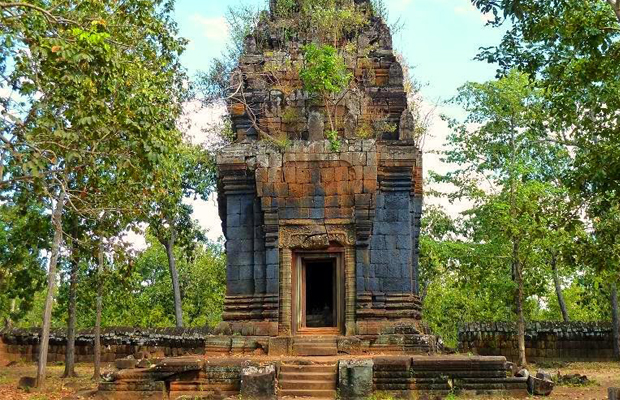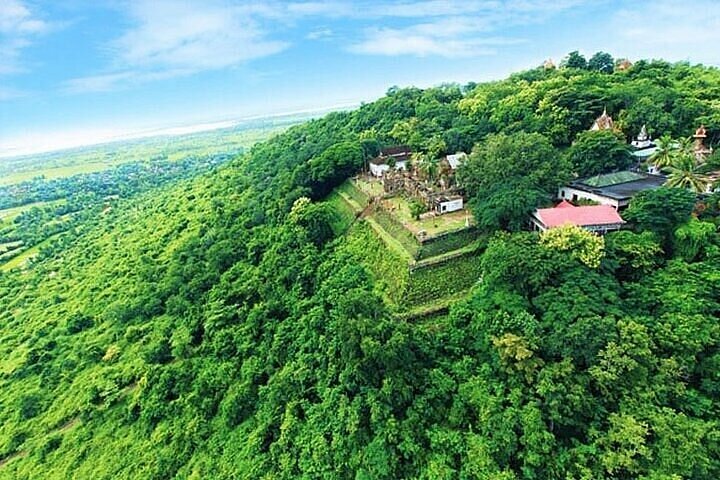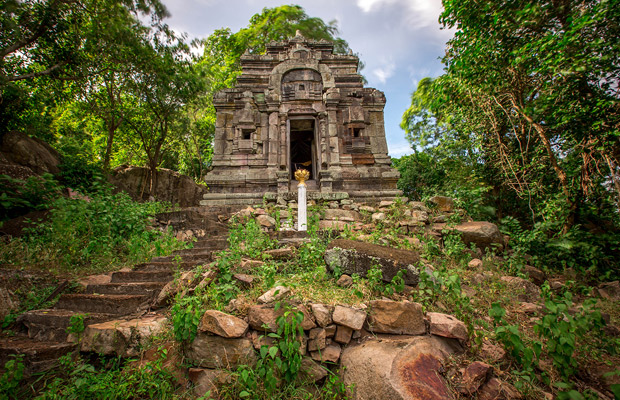Takeo
Takeo
The Neang Khmao Temple is a historical and cultural site located in the Takeo Province of southern Cambodia. It is an important archaeological and religious site, renowned for its distinctive features and historical significance, especially related to Cambodia’s ancient Khmer architecture and Hindu-Buddhist traditions. Neang Khmao Temple is believed to have been constructed during the Angkorian period, around the 10th century. It was likely built during the reign of King Jayavarman VII, who is famous for his construction of many temples and religious monuments across Cambodia, particularly those dedicated to Buddhism. The most remarkable aspect of the temple is the large central tower, which is believed to have originally housed a statue of the goddess for which the temple is named (“Neang Khmao” translates to “Black Lady” in Khmer). The name Neang Khmao (translated as “Black Lady”) is derived from a local legend associated with the temple. According to the legend, Neang Khmao was a beautiful young woman who was in love with a prince. The prince, however, abandoned her, and as a result, she was so heartbroken that she turned into a black stone statue, which was later placed in the temple.
Phnom Chiso Temple, located in Takeo Province, Cambodia, is a significant historical and cultural site, known for its ancient Khmer architecture and beautiful setting. It sits atop Phnom Chiso Mountain, offering panoramic views of the surrounding countryside. The temple is a popular destination for both religious pilgrims and tourists interested in Cambodia’s rich history and culture. Phnom Chiso is believed to date back to the 11th century, during the reign of King Suryavarman I, who ruled from 1010 to 1050. The temple is dedicated to Hindu deities, primarily Shiva, and was later influenced by Buddhism. The temple complex showcases classic Khmer architectural styles, with sandstone carvings, intricate bas-reliefs, and impressive structures. The central tower (prang) is one of the key features of the temple, symbolizing Mount Meru, the center of the universe in Hindu and Buddhist cosmology. The temple is built atop a hill (about 135 meters high), and visitors must climb a series of stone steps to reach it.
Phnom Da Temple is another historically significant site located in Takeo Province, Cambodia. Situated on a hill in the district of Angkor Borei, it is one of the most important archaeological and religious sites in the region, known for its ancient Khmer architecture and historical significance. The temple complex is a blend of both Hindu and Buddhist influences, offering insights into Cambodia’s ancient past. Phnom Da is believed to have been built during the Funan Kingdom (1st to 6th centuries), making it one of the oldest known temple complexes in Cambodia. The Funan Kingdom was the first Indianized kingdom in Southeast Asia, and it had a significant influence on the region’s culture and religion, introducing Hinduism and Buddhism. The temple itself is thought to have been built during the 6th century, with some parts dating to the 7th century. It was originally a Hindu temple dedicated to the god Shiva, and later, Buddhist elements were integrated as the region converted to Buddhism. Phnom Da is situated on a small hill about 98 meters above sea level. The hill offers great views of the surrounding area, which includes a mix of rice fields and small villages. It is located in a relatively remote part of the province, adding to its peaceful and spiritual atmosphere.
Borei Angkor Mountain in Takeo is a lesser-known but scenic and culturally significant location that offers both natural beauty and historical intrigue. Located in the Takeo Province, which is in the southern part of Cambodia, this mountain and its surrounding area provide visitors with a chance to explore nature, local life, and historical sites that are often less crowded than more famous Cambodian destinations. Borei Angkor Mountain is known for its peaceful and lush environment, surrounded by forests, rice fields, and small rural villages. The rolling hills and green surroundings are perfect for nature lovers. The region around Borei Angkor Mountain is dotted with traditional Cambodian villages, where you can observe the daily life of the rural population. Farming, particularly rice cultivation, is a key part of life here. Visitors can interact with the locals, learn about their customs, and explore traditional ways of life that have been passed down for generations.
Create Your Dream Tour!
Feel free to adjust any details or add specific information relevant to your destination or travel agency. Let me know if you need further customization!





